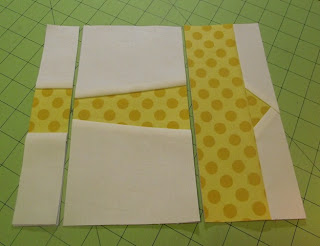Since some of the girls are new to paper piecing, I thought I'd be nice and make up a tutorial. I cut my fabrics to minimize waste while allowing a little bit of wiggle room. I hope this helps you ladies!
Step 1: Print out pattern Lone Eagle Block at 100%
Step 2: Trim pattern to 1/8" away from seam allowance.
Step 3:
From background fabric cut:
2 - 5"x5" squares
2 - 2" x 5" rectangles
2 - 2" x 4" rectangles
From print fabric cut:
1 - 3" x 5" rectangle
1 - 3" x 9" rectangle
2 - 3" x 2" rectangles
Step 4: Fold pattern pieces at sew lines. This will make trimming the seam allowances easier during construction.
Step 5:
Place the 3" x 5" print rectangle (piece #1) wrong side towards the back of the pattern.
Pin in place.
Be sure fabric covers 1/4" seam allowances past all sew lines. This is where the folding comes in handy!
Step 6:

Place a 5" x 5" background square (piece #2) slightly under the print fabric you just pinned in place.
Trim to a 1/4" seam allowance. This gives you straight lines to line up. As an added bonus, your 2nd piece is now the correct shape, eliminating guess work as to how to place correctly to ensure all your seam allowances will be covered.
Step 7:
Using a short (1 mm) stitch length, begin sewing 1/4 " away from the drawn sewing line, and end 1/4" past the drawn line. Back stitch at the beginning and end of your sewn line.
The paper will rip off easily with the short stitch length, and back stitching ensures that you won't pull your stitches when removing the paper.
This photo shows where I started and stopped my stitching. As you can see, I extended my stitches to the edge of the paper.
Step 8: Turn over and press towards piece #2.
Repeat steps 6 - 8 for piece #3, pressing towards piece #3.
Step 9:
It's now time to trim your completed block section. I pin the short edges to prevent the fabric from sliding during cutting. Trim on the 1/4" seam allowance included in the foundation.
Remove pins and admire your handiwork!
The nose piece of the plane is a little bit trickier, but the steps are still the same. Pin your piece #1 (2" x 3" rectangle) in place, ensuring your seam allowances are covered completely.
Trim pieces #1 & #2 (2" x 5" rectangle) the same way you did for the previous section.
Align edges you just cut & pin in place.
Turn over & sew on line between #1 & #2, starting and stopping 1/4 " past line. Remember to back stitch!
Flip over & press towards piece #2.
Repeat for piece #3.

Trim seam allowance to 1/4".
Align straight edge of piece #4 (3" x 9" rectangle) with edge you just trimmed.
Sew together.
Flip over & press towards piece you just sewed on.
Trim on 1/4" seam allowance included on foundation.
Repeat for tail section. Be sure & pin the edges when you trim your completed section to prevent the fabric from slipping.
It's a horrible feeling to complete a piece, then have to do it over because of an error during trimming. Trust me, I know!
Remove paper backing & give all your completed sections a good pressing.
Some people choose to leave the paper on when they sew the sections together, but I find it to be more of a hassle than anything. The paper tends to slide, and it's more difficult to remove.
Sew sections together using a 1/4" seam allowance. Press, and you've now completed your block!!!!
I do hope this tutorial helps! It was my first, and I hope this is easy to understand. :)















3 comments:
You are so awesome for doing this!!! love that yellow fabric you used too!
Thanks so much Melissa for taking the extra time to do this tutorial. Sorry I haven't posted this thank you sooner!
Can't tell you how much this has helped me today. You are just the best.
Post a Comment